In light of a recent forum post about stret-pegging for pike I thought I’d share this with you.
A few decades ago pike were something you fished for when you couldn’t fish for anything else, or you stuck a pike rod out to fish for itself while you concentrated on the ‘real’ fishing. If the river was up and the stillwaters were too cold for roach and bream fishing, you got the pike rods out. Fishing for pike was marginally better than not fishing at all. At least to some anglers, but there were plenty who stayed at home rather than fish for pike.
Of course, there have always been a few pike fanatics, but they were in a very tiny minority compared to the fans of other species. Angling journals had few, if any, features about pike, and the anglers who wrote the pike articles were regarded as quirky, or ‘different’ at least. And, at best, all you could buy in a tackle shop that was specifically pike related was a Fishing Gazette bung and a Jardine Snap Tackle. The rest you had to make yourself.
When you caught a pike you lifted it from the water with a gaff, which was slipped through the soft tissue of the bottom jaw by those few anglers who intended to return the fish. And then you prised its jaws open with a spring-loaded, pointed gag (which almost dislocated the jaws of smaller pike) while you tried to get the rank-barbed trebles out with a pair of pliers. If, like many anglers of that time, you never returned pike, it was thrown up the bank and left to die, or taken home for the pot. The rules of many clubs demanded that pike were never returned, and the maxim of most anglers was that the only good pike was a dead one. Unspeakably cruel acts were meted out on them with boots, rod rests, etc, all stemming from incredible ignorance. What a way to treat a fish that can give you as much sport and pleasure as any other species, and more than most.
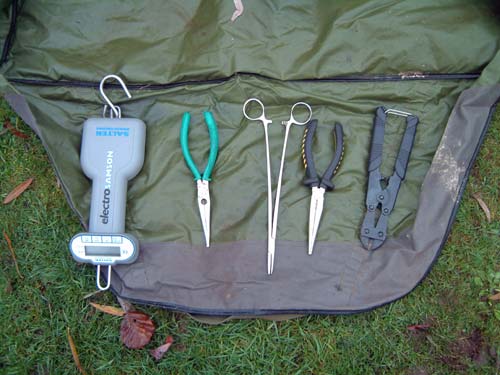
Modern pike care kit
Why the hell did we do it, and why the hell did it take us so long to learn that pike are not the enemy, but a major player in the big angling picture?
How different today. Every coarse angling journal (apart from other single species ones) covers pike in as much depth as any other fish. There is a major organisation, the Pike Anglers Club, catering solely for fans of the species. All major tackle manufacturers have a range of pike fishing tackle. You can buy pike floats to suit all purposes, and almost as many gadgets and gizmos as there are for carp fishing. Today, pike fishing is treated with the same respect as any branch of angling, and while there are some old, pike-hating dinosaurs still out there, the majority of anglers accept pike for exactly what they are: a beautiful, awesome fish with as much right to be in a mixed fishery as any other species.
Pike have enough stature and respect now to demand as much thought about how to catch them as goes towards catching all other species. No longer is it a mindless exercise whereby you impale a minnow or gudgeon on a set of trebles riding under a bung, and then chuck-and-chance-it wherever you happen to be fishing for something else with your No. 1 rod. Not long ago I was thinking about this as I fished a river for pike, using a float-fished dead roach with all the same concentration and tackle manipulation that I would give to float fishing caster for chub.
I was using a 12ft, 3lb test curve rod, a big fixed-spool reel, 15lb line, and 20lb wire trace fitted with two size 8 semi-barbless trebles. Not by any stretch of the imagination can you call that a delicate, refined set-up. However, big, bold and brash the tackle may have been, but above all it was well balanced. You need a heavy rod to cast a heavy bait and to plant treble hooks in big pike. You need heavy line to do that job too, and a wire trace to go with it. Treble hooks are necessary to fish a sizeable baitfish properly. And the whole combination is needed to land big pike. Although the outfit is heavy in every sense of the word, it doesn’t mean that it can’t be handled with flair and finesse.
Float fishing for river pike is something I’ve done a lot of, and the more of it I do the more I realise that good presentation of the baitfish is of paramount importance, no less so than the good presentation necessary with any bait for any species. Get that wrong and one of two things will happen: the fish will not see the bait at all due to it being presented outside the feeding area (and that includes fishing at the wrong depth). Or the bait may be behaving wrongly and causing suspicion. The answer to the former is simple: you experiment by presenting the bait at various depths until you find the depth at which the pike are feeding. The latter can be a mite tricky, but more of that soon.
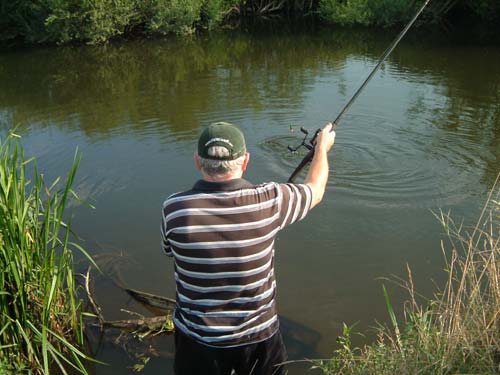
Graham plays a river pike
The usual spots to fish for river pike are the slacks. In slack water – and I mean really slack, with hardly any more flow than you would get in a big stillwater when there is a big blow on – there isn’t a problem. Or no more problem than if you really were fishing a big stillwater, for the baitfish can be swimming in each and any direction. Remember that what I am referring to applies to both live and dead baits, for a suspended deadbait has to give the illusion that it is live, otherwise it would be floating at the surface or lying on the bottom. Presentation is therefore quite easy; the leading treble in the root of the pectoral and the upper treble in the root of the dorsal: the hooking method used by many pike anglers no matter what the situation is. It is when fishing flowing water that presentation has to be given a lot more thought.
And think on this: pike can be found more often in the flow than in the slacks when they are hunting food. They will be where the prey can be found, and when that prey is dace, roach, grayling, perch and small chub the most likely place to find them is right in the flow, or at least at the edge, along the crease. Pike won’t hang around in the slack water if there are no prey fish in the slacks. Indeed, I’ve caught pike from some of the fastest currents I’ve ever fished for any species, especially in some really racy grayling swims.
Pike are no different than any fish when they’re hungry. They can be incredibly stupid. There are days when big fish of all species will take a crudely presented bait. How often have you gone through a rough patch, struggling to catch a decent fish for weeks on end, and then seen a complete novice extract a big fish on a tackle, rig and bait that made you want to throw up? Too often probably. And then you have to remind yourself that the more sophisticated tackle, rig and bait presentation you are using is designed for those days when they are not so hungry and exercising their usual caution. They are the days when you are successful and the novice blanks. So, a suspended baitfish, set to fish at practically any depth, and hooked to hang horizontally, will score on those days when the pike are hungry enough to throw caution to the wind. They will be hunting food in each and every direction and willing to accept anything that comes within striking range.
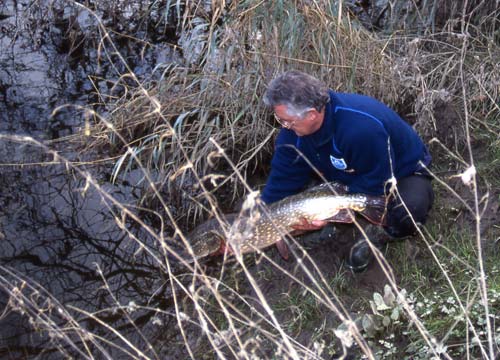
Graham returns a 23lb river Wye pike he caught stret-pegging
There are four float-fishing methods I use to fish for river pike and you can never be sure which is the best method on the day until you have fished for a while and experimented somewhat. The first method is the conventional suspended bait under a float for fishing the usual slack water at the side, or in water flowing so slowly the current is negligible. The second method is a paternostered sunken float, the third is similar to fishing a slightly overdepth stickfloat and used in any kind of flow, fast or slow. And the fourth method is a kind of stret-pegging, where you fish the bait several feet overdepth, leave it float-legered for a while, and then randomly feed it down the flow, along the bottom, in erratic stops and starts to float-leger the full length of the swim, which can be up to 50yds or so.
Method one, the usual, conventional technique used by everyone at some time or other, is the first choice. And why not? There is no point using the more difficult methods for flowing water if the pike are lying in, or on the edge of, slack water and open to some easy pickings. So, I hang a bait – live or dead, depending what I have with me, but preferably live – from the trebles, under a sliding pike float, and set off for a walk along the river, dropping the bait in every likely looking slack pocket I come across. I use a powergum stop-knot that grips the line enough not to slip as it shoots through the rod rings, but will slide easily without kinking the line as I adjust the depth for each swim I fish.
The second method, a paternostered bait with a sunken float, I use when I take a break for a brew and/or a sandwich, or when I wish to exploit a particular spot, usually right on the crease. Set the bait to fish at whatever depth you think is right – I usually start about 6ins off bottom – tighten to the float, and clip the line to the rod. That way the pike can snatch the line from the clip on its first strike, when it is least likely to feel anything untoward, and is then free to take off with the bait on an unrestricted run, which, of course, you hit immediately.
Method three is a brilliant technique for flowing water, allowing you to cover a stretch of water up to about 50yds. It can be hard work with a heavy rod and reel but is well worth it on the right day, for the returns can be a bit special. Use a slim pike float; the pencil variety, that will hold back in the flow without too much resistance. It can be a sliding float as normal, or fixed top and bottom like a normal stick float. Sliding is better, for the line coming from the top centre of the float gives you better control and, of course, it is easily adjustable when you wish to alter the depth. To fish the method correctly you need to fish overdepth and be over-shotted, for remember, you will be holding back against the flow, which will keep the float well above surface. Fish about a foot overdepth, and where, say, a 1/4oz bullet is normally sufficient, use 1/2oz. This should be positioned just above the trace, which should be about 15in to 18ins long, and held off the knot to the trace swivel with a rubber bead. You can also add SSG shot to the trace itself if necessary.
Use a deadbait, a roach or dace of about 3oz to 4oz is ideal, and I’ve had great success with small herring, joey mackerel and smelt too. There is no point in using a livebait for you will kill it in no time anyway from repeated trotting and retrieving. To begin with mount the bait on a pair of trebles so that it hangs tail down, the top hook through both lips and the bottom hook about half way down one flank. Bind the fish on with knitting-in elastic, a few turns around the shank of the flank treble. This is a very fine elastic with a diameter about the same as 2lb line, and can be bought from most haberdashery shops. It is important, at least in this first instance, that the fish hangs tail down, for you are about to try to imitate a fish that is swimming against the current, as they do. River fish occasionally turn downstream, but generally they swim against the current and drop downstream a short distance tail first.
When trotting the bait down the swim it is this action you should try to simulate. Hold back the float and allow the bait to drop downstream a little slower than the pace of the current; stop the float completely and allow the bait to rise in the current, then let the float go so that the bait sinks and runs downstream. Vary the technique by holding back for longer (to allow the bait to rise right to the surface) and for short spells (to allow the bait to rise to mid-water or thereabouts). You can really play around with the technique to make the bait run through the current at varying depths and with various actions.
Another variation of this same method is to shallow up to only a few inches overdepth and with the bait mounted head down. Now trot the bait down the swim, holding back frequently to allow the bait to rise a few inches, and then drop back to the bottom. The baitfish will appear to be standing on its head on the bottom, as if feeding, then dropping downstream to feed again.
With either variation you will be maintaining a tight line to the float, but most of the time the takes are surprisingly gentle. The float normally sinks slowly away just as though you have snagged the bottom. Obviously, the pike has grabbed the bait and lay on the bottom to allow it to slip down its throat before moving off. I strike at all float ‘stoppages’ just in case a pike is the culprit and to ensure that I do everything I can to avoid deep hooking.
The final method, stret-pegging, or at least a variation of it, is one of my favourites. I’ve done a little of it for some years, but I saw the method fished superbly by the Swedes when in their beautiful country a few years ago to do a slide show with Mick Brown. The locals used the stret-pegging method on the mouth of a river that flows into the Baltic Sea and caught a 44-pounder and several others over 30lb whilst we were there.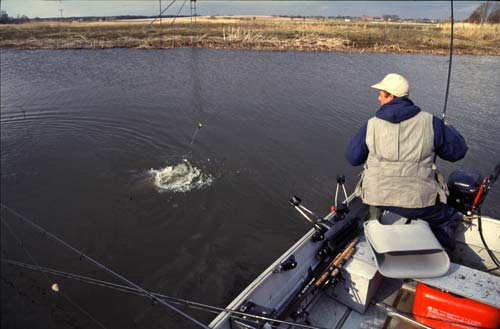
A big pike that took a stret-pegged roach in Sweden
You tackle up the same as for trotting, but this time with the float set to fish several feet over depth. Most important is to use enough lead on the line – but only just enough lead – to keep the bait on the bottom. This time you can use a livebait if you wish, for you will not be casting and retrieving the bait too often.
It is best fished from a boat, but can be fished very effectively from the bank when you can fish more or less directly downstream. You swing the bait in and allow it to sink to the bottom and then tighten up to the float. The bait will be resting on the bottom with its head facing upstream, just as a fish does. A slight lift of the rod will cause the bait to dislodge from the bottom and then drop slowly downstream until you stop it, but a yard or so at a time is about right. Each time you stop it you can leave it there for long or short spells. The time to especially watch for a take is when the bait has been lay in one spot for a while and you make it twitch and glide downstream. Pike have this habit of eyeing a bait for a while before they pounce, and they are often provoked into pouncing when the object of their attention makes an unexpected move!
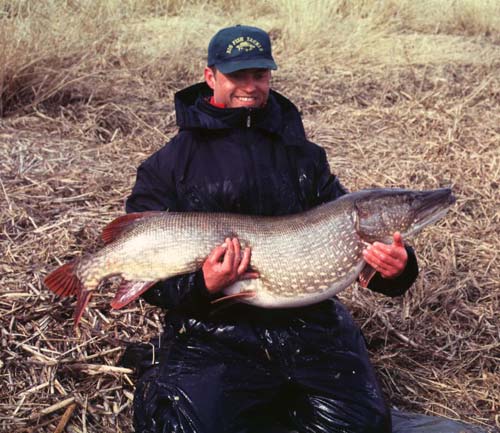
A 44-pounder caught on live roach stret-pegged from a boat
Again, there is some scope for varying the action of the bait, but the method is basically a means of float-legering a bait for varying periods in many different spots down the length of a swim. There is, of course, no reason at all why the bait should not be mounted in any direction, but I’ve found that mounting it head up is the most effective.
Give it a try this winter.










